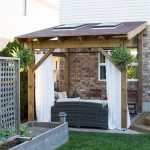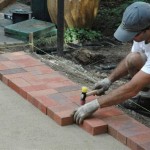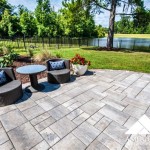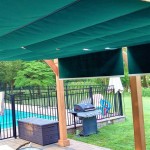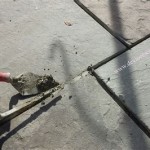How To Build A Patio On Uneven Ground
A patio is a fantastic addition to any home, providing an outdoor space for relaxation, entertaining, and enjoying the fresh air. However, building a patio on uneven ground can present unique challenges. Uneven ground can lead to an unstable patio, drainage issues, and an uneven surface that is uncomfortable to walk on. But with proper planning and execution, you can successfully build a patio on uneven ground.
1. Preparing the Site
The first step is to prepare the site by leveling the ground. This involves removing any existing vegetation, debris, and loose soil. To determine the amount of leveling required, use a level and a measuring tape to find the highest and lowest points on your patio site. The difference between these points will tell you how much you need to adjust the ground level.
For minor adjustments, you can use a shovel or rake to redistribute the soil. However, for larger adjustments, you will likely need to bring in additional fill material, such as gravel, sand, or topsoil. Consider using a compactor to compact the fill material, ensuring it's stable and won't settle over time. Removing existing vegetation and debris not only prepares the site for construction but also helps prevent future problems with insects, weeds, and soil erosion.
2. Creating a Solid Base
A solid base is crucial for a stable and long-lasting patio. If you're building a patio on uneven ground, it's essential to lay a layer of gravel or crushed stone before adding the patio material. This creates a drainage layer and prevents the patio from settling. The thickness of the gravel layer will vary depending on the amount of unevenness in the ground. For minor unevenness, a 4-inch layer may suffice. For steeper slopes, you may need to use a thicker layer, up to 6 inches.
After laying the gravel, compact it thoroughly using a plate compactor or hand tamper. This ensures the gravel is evenly distributed and provides a stable foundation for the patio material. When selecting gravel or crushed stone, choose a material that is durable, drains well, and won't break down easily. It's also essential to use a landscape fabric underneath the gravel to prevent weeds from growing through the patio.
3. Choosing the Right Patio Material
The choice of patio material depends on your preferences, budget, and the climate in your area. Popular options include concrete, pavers, and natural stone. Concrete is a durable and affordable option but requires a skilled hand to achieve a smooth and even finish. Pavers are versatile, allowing for various design patterns and easy installation. Natural stone offers a unique and elegant look but can be more expensive than other options.
When building a patio on uneven ground, it's crucial to select a material that can accommodate the uneven surface. Pavers are an excellent choice because they can be laid on a slightly uneven surface. However, if you choose concrete or natural stone, you may need to create a level base using a combination of gravel, sand, and mortar. Careful planning and installation are essential for a successful patio on uneven ground, regardless of the material chosen.
4. Dealing with Drainage
Proper drainage is crucial to prevent water from pooling on your patio and causing damage. If your patio is on a slope, you need to incorporate a slight slope to direct water away from your house and towards a drainage area. This can be achieved by laying the patio material with a slight downward slope. If the slope is significant, you may need to install a drainage system, such as French drains or dry wells, to collect and divert water away from the patio.
When planning your patio's drainage, consider the direction of the slope, the amount of rainfall your area receives, and the soil composition. These factors will influence the type of drainage system you need to install. It's always advisable to consult with a professional landscape architect or contractor for guidance on drainage solutions, especially if you're dealing with a significant slope or problematic soil conditions.
5. Finishing Touches
Once your patio is built, you can add finishing touches to enhance its appearance and functionality. This includes adding landscaping features, such as plants, flowers, and trees. You can also install lighting, seating, and other outdoor amenities to create a cozy and inviting space. When choosing landscaping features, consider the size and layout of your patio, the climate in your area, and the overall aesthetic you want to achieve.
Lighting can significantly enhance the ambiance of your patio, especially in the evening. Consider installing string lights, spotlights, or path lights to create a warm and inviting atmosphere. Other outdoor amenities, such as a fire pit, grill, or outdoor kitchen, can add functionality and enhance your enjoyment of the patio.
Building a patio on uneven ground can be challenging but rewarding. With proper planning, preparation, and attention to detail, you can create a stunning outdoor space that you can enjoy for years to come. Remember to consider the factors discussed above, and don't hesitate to seek professional guidance if needed. Let your imagination run wild and create a patio that reflects your unique style and provides a relaxing and enjoyable escape from the everyday.

How To Lay Decking On Uneven Ground Pi Gardening

Building A Surface Deck Over An Uneven Concrete Patio

Building A Floating Deck On Uneven Ground

How I Built My Floating Deck On Uneven Ground

Retaining Walls Make Beautiful Raised Patios

How To Install Composite Wood Decking On Uneven Ground Unfloor

Back Yard Patio On Sloped Terrain Small Garden Backyard

How To Lay Decking On Uneven Ground 2 Simple Methods

My Garden Is Sloped Can I Still Install A Patio Home Logic

How To Build A Shed Base On Uneven Ground Tiger Sheds
Related Posts

